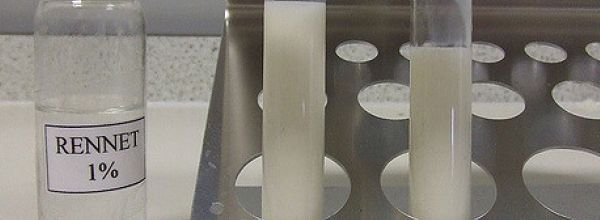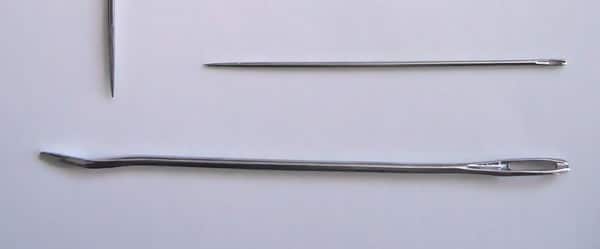Protease inhibitors are widely used in molecular biology labs. Read on to discover why they are needed, how to use them safely and how to store them correctly.
Problematic Proteases
Proteases are present in all living organisms. They break peptide bonds in proteins and are involved in a multitude of cellular processes and pathways, ranging from simple to complex.
Without them, your blood wouldn’t clot. Apoptosis, the process by which cells turn over under normal conditions, would cease to occur. Pepsin and trypsin would fail to help us digest tasty protein-packed meals.
Worst of all, you might not be able to get stains off your clothes, because proteases are a common additive in many laundry detergents (gasp)!
All joking aside, proteases are clearly essential for cells to function normally. That’s all fine and good for life as we know it, but proteases can be a major pain in the neck when it comes to expressing and purifying proteins in the lab.
Whenever you lyse cells, the compartmentalization and inhibition that keeps native proteases in check is broken, and you unleash potential havoc on your precious proteins of interest.
Why Are Proteases a Problem During Cell Lysis?
Cell lysis disrupts membranes, including those that sequester proteases, which are carefully kept in check by the cell during normal metabolism. After that barrier is lost, whatever proteases your cell line expresses are free to begin work on the rest of the free proteins in solution.
Adding protease inhibitors as a component of lysis buffer means that you can have a preventative measure ready to go even before cell membranes are ruptured during the lysis process.
Even if you’re unaware of the diverse array of protease inhibitors that exist, odds are you’ve used at least one or two of them if cell lysis is a typical part of your work (I’m looking at you, EDTA!).
Now we know why proteases are needed, let’s look into how they work.
What Are Protease Inhibitors and How Do They Work?
Protease inhibitors aren’t a family of molecules related by structure. Rather, protease inhibitors are defined by their function: they inhibit proteases, as their name implies.
Technically speaking, protease inhibitors include any chemical or biological compounds that bind to proteases to inhibit their function reversibly or irreversibly. Their size and molecular weight vary widely, and the classification includes small chemicals, peptides, and even other proteins.
Protease inhibitors can be classified in many ways. When you shop for protease inhibitors, you’ll find that they are often grouped by the type of protease they inhibit. However, we can classify them broadly based on whether they are reversible or irreversible inhibitors.
Reversible Inhibitors
A reversible inhibitor binds to an enzyme’s active site through non-covalent interactions. A good example of a reversible protease inhibitor is aprotinin, which inhibits most serine proteases by competing with the natural substrate for the active site. For reversible protease inhibitors to work well, you must ensure that an appropriate concentration of the inhibitor is used so that it can effectively outcompete the natural protease substrate (your precious proteins!).
Irreversible Inhibitors
Conversely, an irreversible inhibitor binds to the active site in a manner that prevents function permanently. For instance, E-64 is an epoxide that covalently modifies the active site cysteine involved in the nucleophilic attack in cysteine proteases, rendering the protease forever inactivated and unable to split any future peptides it would have otherwise chopped up.
Within these two groups of protease inhibitors, there is a big range in affinity for various proteases. Thankfully, most common protease inhibitors have suggested working concentration ranges, and their mechanisms are well understood by the scientific community—making your life easier when it comes to selecting inhibitors to use in your work!
Commonly Used Protease Inhibitors
Having a solid understanding of how individual protease inhibitors work provides a firm foundation for their use, even if you decide on using a cocktail—most of which include some combination of the most common protease inhibitors below (table 1).
Table 1. Commonly used protease inhibitors in the lab, their targets, and working concentrations.
| Protease Inhibitor | Target | Type | Example Stock Conc. | Solvent Temp Stability | Working Conc. (1X) | Tips & Notes |
| AEBSF | Serine proteases | I | 100 mM | H2O –20°C 3 months | 0.2–1.0 mM | Water soluble unlike most other serine protease inhibitors Can covalently modify certain amino acid residues in other proteins, so consider this when purifying proteins for downstream mass spectrometry or gel electrophoresis |
| Aprotinin | Serine proteases | R | 10 mg/mL | H2O –70°C 6 months | 100–200 nM | Dissociates from proteases at extreme pHs (<3 or >10) |
| Bestatin | Certain amino-peptidases | R | 2–5 mg/mL | MeOH –15 to –25°C 6 months | 1–10 \muM | Low stability in aqueous solutions |
| E-64 | Cysteine proteases | I | 1 mM | H2O – 20°C 6 months | 1–20 \muM | High specificity to target proteases and highly soluble in aqueous solutions |
| EDTA | Metallo-proteases | R | 0.5 M (pH 8) | H2O 20°C 1 year | 2–10 mM | Chelates (and therefore sequesters) divalent metals so that metalloproteases cannot function Water soluble and stable in aqueous solutions NOT compatible with immobilized metal affinity chromatography (will strip the nickel off of purification columns!) or 2D gel electrophoresis |
| Leupeptin | Serine, cysteine, & threonine proteases | R | 10 mM | H2O 4°C 1 week or -20°C 6 months | 10–100 \muM | Water soluble but low stability at working concentration May affect protein concentration quantitation assays such as Bradford Assay |
| Pepstatin A | Aspartic proteases | R | 1 mM | DMSO –20°C 6 months | 1–20 \muM | Highly stable but very low solubility in water |
| PMSF | Serine proteases | R | 1 M | DMSO –20°C 6 months | 0.1–1.0 mM | Limited solubility and highly unstable in aqueous solutions. A known neurotoxin—exercise caution when using! |
Choosing the right Inhibitors: The Importance of Cocktails
But wait! How do we select a single, magic bullet protease inhibitor that will prevent all proteases from degrading proteins in our lysis workflow? The fact is, there ISN’T a protease inhibitor that will inactivate all known proteases.
Single proteases are often used when the goal is to remove tags from already-purified proteins. In most other instances where broad action against native proteases is desired, a “cocktail” of several protease inhibitors will do the trick and are a popular option. These cocktails come prepared as concentrated solutions or even sometimes as convenient tablets.
Most commercially available cocktails come as a combination of six inhibitors: AEBSF, Aprotinin, Bestatin, E-64, Leupeptin, and Pepstatin A. With the addition of EDTA, a broad-acting cocktail covers nearly all your bases in most cell lysis and purification workflows (EDTA is typically suggested as optional, as it can interfere with certain experiments).
Cocktails are an especially convenient, cheap, and reliable means of inhibiting proteases and are very popular in labs. Refer to your supplier’s datasheets and protocols to decide on the amount of a cocktail to add to your lysis buffer.
Considerations When Using Protease Inhibitors in The Lab
Below are a few things to keep in mind when deciding to use a protease inhibitor in your work.
Storage
Several protease inhibitors are especially unstable when kept at room temperature or even in refrigerated conditions for prolonged periods of time. Furthermore, the stability of protease inhibitors varies at their working (or 1x) concentration.
As long as you store inhibitors appropriately and according to vendor directions, however, they should function as intended when you are ready to use them. One exception to this is PMSF, which may require multiple additions to keep proteases at bay.
Safety
While most protease inhibitors are recognized as generally safe with standard microbiology lab PPE, there are some special cases. Some inhibitors are prepared as concentrates in organic solvents and acetic acid.
PMSF acts as a neurotoxin and should be handled in a fume hood.
Bottom line: ALWAYS review the safety data sheet on any new reagent you use in the lab, including commercially available protease inhibitors.
Compatibility with Your Workflow
While several protease inhibitors target certain classes of proteases fairly specifically, there are cases where you may want to exclude certain inhibitors that are not suitable with downstream activities in your work.
For instance, EDTA is an excellent metalloprotease inhibitor because of its ability to chelate divalent cations that metalloproteases require in their active sites to catalyze proteolysis. But EDTA will also strip the nickel off protein purification columns often used to purify His-tagged proteins.
Other protease inhibitors do not function at extremes of pH or temperature.
Generally speaking, you’ll probably get off to an excellent start by consulting the instructions provided with protease inhibitors from vendors, including how to best handle and utilize your inhibitor(s) of choice.
Do you use protease inhibitors regularly in your work, or have tips or additional advice? Let us know in the comments below, and happy inhibit-ing!
Resources
- The Protein Man. How to select the right protease inhibitor. G-Biosciences. Published 8 August 2017. (Accessed 1 November 2021).
- The Protein Man. Why Should I Have an Inhibitor Cocktail? G-Biosciences. Published 1 December 2015. (Accessed 1 November 2021).
- Protease and Phosphatase Inhibitors. Thermo Fisher Scientific. (Accessed 1 November 2021).
- The Complete Guide for Protease Inhibition. Roche Applied Science. (Accessed 1 November 2021).
- Caroline Ritchie. Protease Inhibitors. Labome. Published 8 August 2021. (Accessed 1 November 2021).
- Brianna Bibel. Protease types, inhibitors, & use-don’t uses. Published 15 September 2020. (Accessed 1 November 2021).







